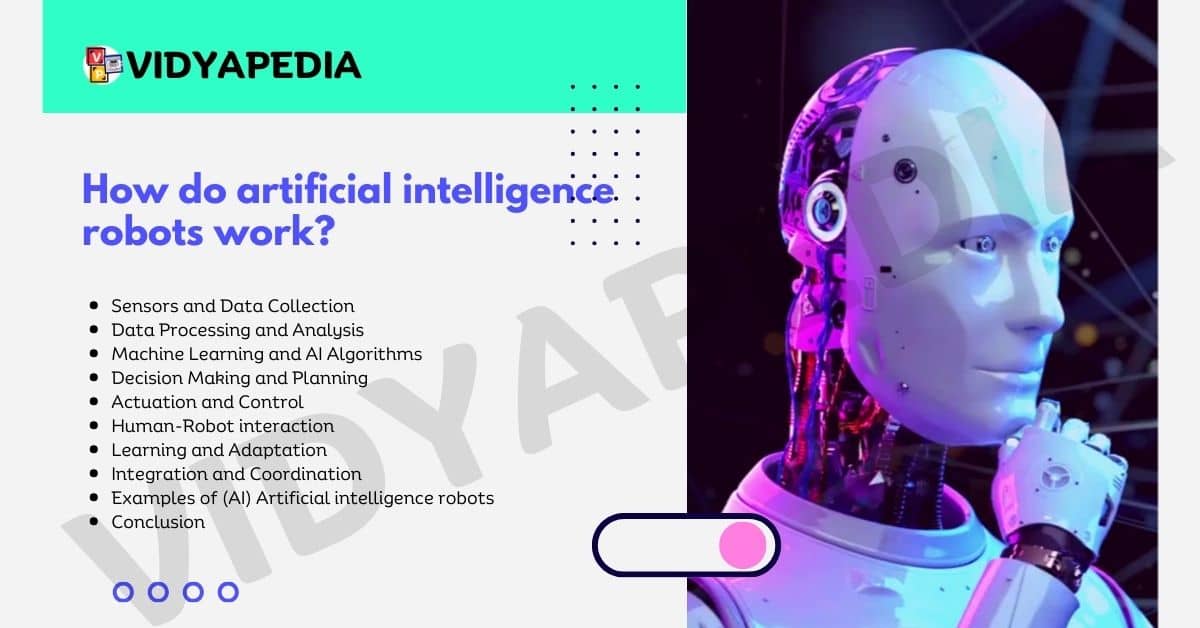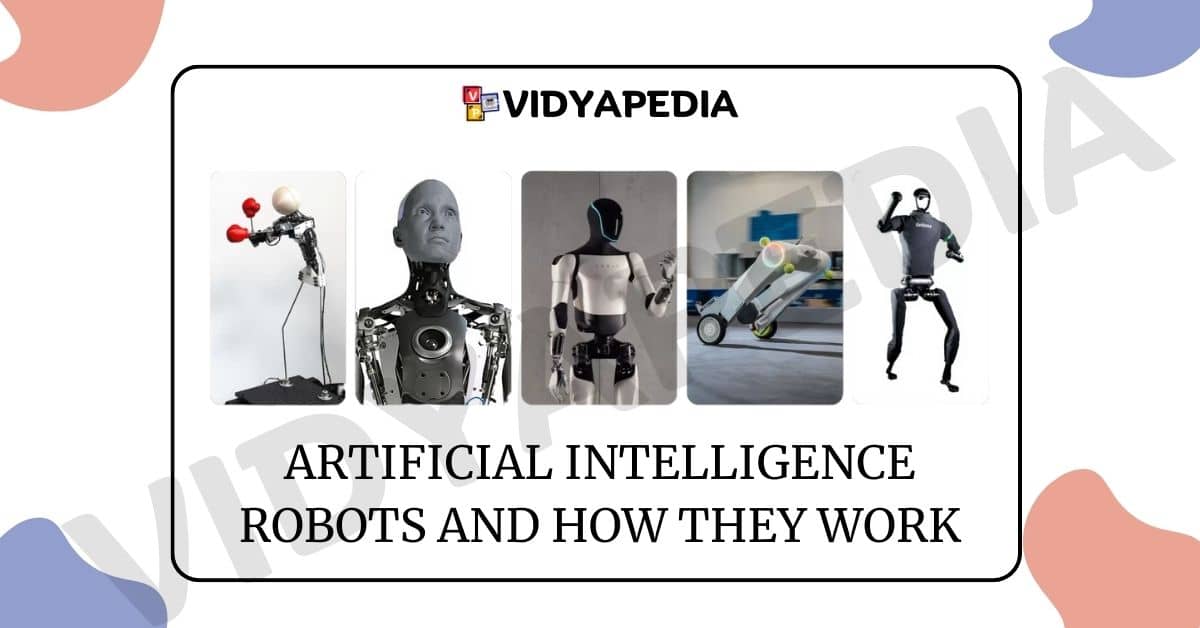Introduction
(AI) Artificial intelligence robots are a fascinating convergence of AI and robotics, combining AI’s cognitive skills with robots’ physical abilities. These powerful machines are designed to accomplish tasks that would normally require human intellect, such as learning, reasoning, problem-solving, and natural language comprehension. The significance of (AI) Artificial intelligence robots in current society cannot be overemphasized, as they alter industries, increase efficiencies, and improve our daily lives.
How do artificial intelligence robots work?

(AI) Artificial intelligence robots are advanced machines created for performing jobs that would normally require human intelligence. These robots use a variety of technologies and techniques to attain their functioning. Here’s a summary of how AI (artificial intelligence) robots operate:
- Sensors and Data Collection
- Data Processing and Analysis
- Machine Learning and AI Algorithms
- Decision Making and Planning
- Actuation and Control
- Human-Robot Interaction
- Learning and Adaptation
- Integration and Coordination
- Examples of (AI) Artificial intelligence robots
- Conclusion
Sensors and Data Collection
Sensors: (AI) Artificial intelligence robots use a range of sensors (such as cameras, microphones, LIDAR, and ultrasonic sensors) to collect information about their surroundings.
Data Collection: These sensors gather raw data from their surroundings, which is critical for the robot’s understanding and interaction with the world.
Data Processing and Analysis
Preprocessing: Raw data from sensors frequently requires preprocessing to remove noise and additional data.
Feature Extraction: Significant features are extracted from preprocessed data, such as outlines in photographs or patterns in audio waves.
Machine Learning and AI Algorithms
Training Models: Artificial intelligence robots utilize machine learning algorithms to learn from data. This entails training models on big datasets to recognize patterns, forecast outcomes, and improve performance over time.
Deep Learning: To obtain high accuracy in tasks like picture and speech recognition, deep learning models such as neural networks are used.
Decision Making and Planning
Algorithms: (A) Artificial intelligence algorithms evaluate processed data and make decisions. These can range from simple rule-based systems to complex algorithms like reinforcement learning.
The robot plans its activities based on the decisions it has made. This requires identifying the best course of action to achieve a specific goal.
Actuation and Control
Motors and Actuators: AI robots use motors and actuators to move and interact with objects.
Control Systems: Algorithms ensure that the robot’s motions are accurate and synchronized. This includes real-time modifications depending on feedback from sensors.
Human-Robot Interaction
Natural Language Processing (NLP): AI robots frequently employ NLP to comprehend and respond to human language, allowing them to successfully converse with users.
User Interfaces: Robots may use a variety of interfaces (e.g., touchscreens, voice instructions) to interact with humans.
Learning and Adaptation
Continuous Learning: Advanced Artificial intelligence robots can continue to learn from fresh data and experiences. This enables them to adapt to new settings and increase their performance over time.
Reinforcement Learning: Some robots learn through reinforcement learning, in which they receive rewards or penalties for their behaviors and optimize their behavior to maximize rewards.
Integration and Coordination
Multi-Robot Systems: In some circumstances, AI robots work along with other robots or systems. Effective communication and collaboration are required to achieve mutual goals.
Data processing and AI computations can be split between the robot (edge computing) and remote servers (cloud computing) to increase efficiency and capabilities.
Top Artificial Intelligence Robots In 2023 And 2024
Top AI Robots in 2023
- Tesla Bot (Optimus)
- Boston Dynamics’ Atlas
- SoftBank Robotics’ Pepper
- Roboy 3.0
- UBTECH Robotics’ Walker
Top AI Robots in 2024
- Tesla Bot (Optimus)
- Boston Dynamics’ Stretch
- Xiaomi CyberOne
- Agility Robotics’ Digit
- Honda Asimo
Table Of Artificial Intelligence Robots Derived In 2023 and 2024
| Year | AI Robot | Developer | Description |
|---|---|---|---|
| 2023 | Tesla Bot (Optimus) | Tesla, Inc. | A humanoid robot is designed to perform repetitive and dangerous tasks, focusing on household chores and factory work. |
| Boston Dynamics’ Atlas | Boston Dynamics | A bipedal robot known for its agility and ability to perform complex physical tasks such as running, jumping, and parkour. | |
| SoftBank Robotics’ Pepper | SoftBank Robotics | A social humanoid robot designed for customer interaction and service roles in retail, hospitality, and healthcare. | |
| Roboy 3.0 | Devanthro Society | A humanoid robot designed to mimic human physiology is aimed at research in biomechanics and human-robot interaction. | |
| UBTECH Robotics’ Walker | UBTECH Robotics | A bipedal humanoid robot capable of smart home control, security, and entertainment. | |
| 2024 | Tesla Bot (Optimus) | Tesla, Inc. | Continued development with enhanced capabilities for household and industrial tasks, improved dexterity, and AI-driven interaction. |
| Boston Dynamics’ Stretch | Boston Dynamics | A mobile robot designed for warehouse automation is capable of moving boxes and handling logistics tasks efficiently. | |
| Xiaomi CyberOne | Xiaomi | A humanoid robot with advanced sensing capabilities, designed for home assistance, security, and interaction. | |
| Agility Robotics’ Digit | Agility Robotics | A bipedal robot optimized for logistics and delivery tasks, capable of navigating complex environments and handling packages. | |
| Honda Asimo | Honda | One of the most advanced humanoid robots has improved AI for performing various tasks, including household chores and interacting with people. |


